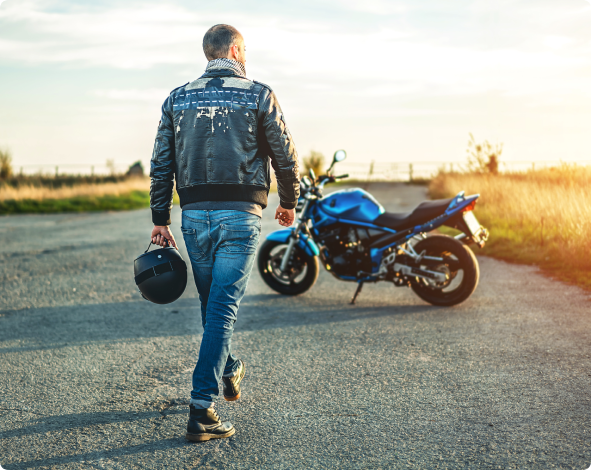What to do after a motorcycle accident
Updated October 24, 2023 . AmFam Team
Quick checklist: 9 steps to take after a motorcycle accident
Before we go over each step in detail, here’s the full list for your convenience:
- Get out of harm’s way: If you’re physically able, pull yourself out of the road.
- Get help: Call 911 and receive medical care, even if you don’t think anything’s wrong.
- Check yourself out: Carefully feel around for any injuries or sources of pain.
- Don’t remove your gear: Your helmet and other safety accessories might be helping you even now.
- Scan your surroundings: Take in the details at the scene of the accident to avoid danger, then remember them for later.
- Get pictures of the scene: Any shots you snap may be useful as visual evidence.
- Talk with anyone involved or present: Record insurance info and eyewitness accounts.
- Get a copy of the motorcycle accident report: The info in the police report can come in handy when talking with insurance agents.
- Contact your insurance company: File a claim right away!
Get out of harm’s way
If possible, move to the side of the road. Some motorcyclists’ first instinct after an accident is to worry about their bike. For now, though, leave it as it is. You just got into a motorcycle accident — put yourself before your ride and reach a safe location.
Get help
Whether you feel perfectly awful or perfectly fine, you or an able bystander must call for emergency services. If it seems unnecessary, just say this aloud: “I was in a motorcycle accident.” . Trained medical professionals may notice what you can’t, so call 911 right away.
Check yourself out
Emergency services will appreciate any info you can provide on how you’re feeling. Get in a position that causes the least strain on your body. Once you’re as comfortable as you can get, try to perform a careful and basic medical check on yourself. Slowly test which limbs you can move. Assess where you feel pain. Consider if you’re nauseous or dizzy.
Don’t remove your gear
Motorcyclists wear safety gear to minimize injuries and reduce risk . Your jacket and helmet might be protecting you from problems you don’t even notice in the post-accident rush of adrenaline. Leave your gear on until a medical professional says otherwise. They can help you safely remove it if needed.
Scan your surroundings
If possible, look around at the scene of the accident. Do you see anyone else with an injury? Are the motorcycle and its parts in the way of traffic? How are the weather, conditions of the road, lighting in the area? Use this information to avoid any further threats. Try remembering it afterward for a more accurate motorcycle accident report.
Get pictures of the scene
Law enforcement agents will be among the emergency services to arrive at the scene. As you wait for everyone to arrive, take pictures of everything. Don't touch the motorcycle or any parts (Opens in a new tab), though — their placement is evidence of what happened, and the effort might worsen your injuries. Shoot the photos from as many angles as you can while staying safe, and show the weather conditions as well. The visual evidence may come in handy.
Talk with anyone involved or present
Sometimes, motorcycle accidents only involve the motorcyclist. Other times, it may involve another driver, or someone whose property was damaged in the incident. Everyone involved should be aware of everyone else’s insurance situation. It may also help your case to get quotes and contact info from eyewitnesses who are otherwise uninvolved. Ask anyone else present for their account and record it with their permission.
Get a copy of the motorcycle accident report
When the police investigate accidents, they compile their findings into a document. As someone involved in the incident, you can request a copy for yourself. The motorcycle accident report (Opens in a new tab) includes statements from involved parties and witnesses, recorded observations of the scene, and more. All this information is essential when filing an insurance claim.
Contact your insurance company
Motorcycle insurance is a must-have, and not just because most states legally require it for riders. It can help cover hospital bills, which can mean paying less or even paying nothing for treatment. Once you’re out of danger with everything else taken care of, contact an insurance agent while you’re recovering. File an insurance claim as soon as you can. As with everyone else, be completely honest about the details of the accident.
Request a motorcycle insurance quote today
We hope that you never have reason to need the information in this guide. With that said, knowing what to do after a motorcycle accident might make a huge difference someday. So can having motorcycle insurance with American Family Insurance. Speak with an agent today about our coverages, including collision coverage, and get a quote.
This article is for informational purposes only and based on information that is widely available. This information does not, and is not intended to, constitute legal or financial advice. You should contact a professional for advice specific to your situation. This article does not afford, offer, or guarantee any coverage.

